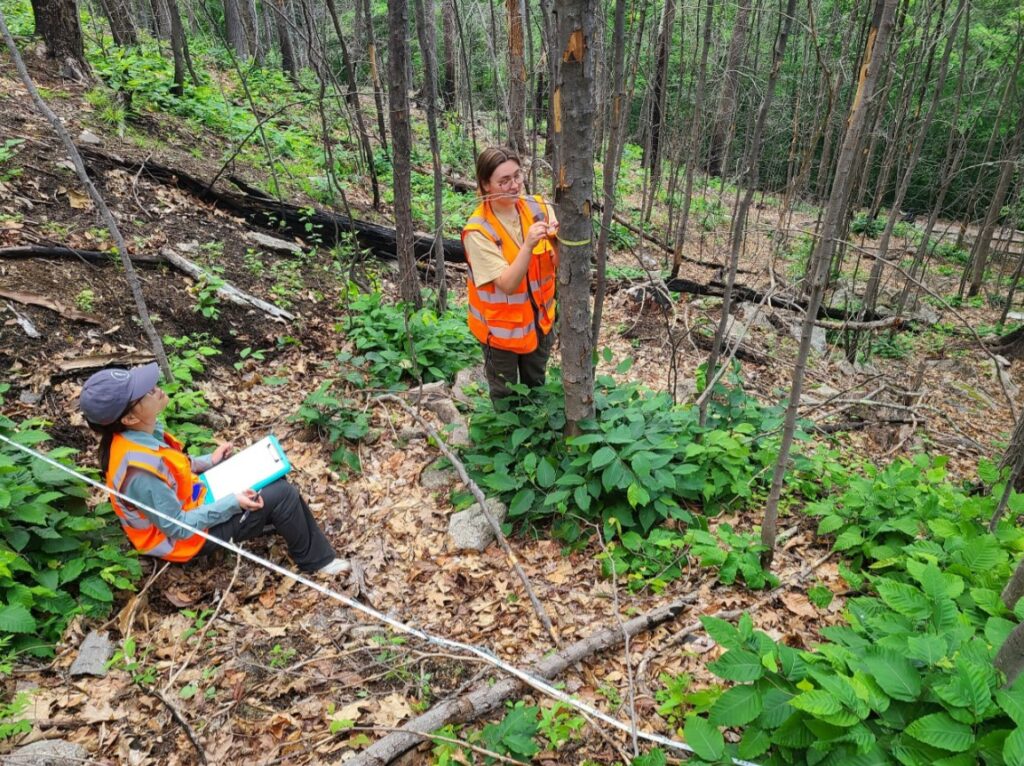From UNH News Service: Research led by Matthew Vadeboncoeur, a research scientist with UNH’s Earth Systems Research Center at the Institute for the Study of Earth, Oceans, and Space, is investigating how prescribed fire could be used improve red oak regeneration and expand its range northward.

Khanh Ton (left) and Abigail Powell (a summer research experience for undergraduate [REU] student from Duquesne University) conducting a vegetation survey in the burn stand at Crawford Notch State Park. In this image, they are measuring the diameter at breast height of a standing dead American beech left by the fire. (Photo by Nat Cleavitt)
The use of prescribed fire as a tool for species regeneration, preventing catastrophic wildfires and for controlling invasive species and removing old vegetation to make room for new growth is a practice more common in the more arid environments of the West and Midwest than in heavily forested New Hampshire and Northern New England. In the White Mountain National Forest, it’s used sparingly by Forest Service officials, sometimes as a management tool to limit the risks of wildfires to populated areas. But the practice of prescribed fire as a conservation tool dates back centuries and was commonly used by Indigenous peoples.
“There’s some skepticism among New Hampshire forest managers if prescribed burns are worth the cost or inherent risk,” added Vadeboncoeur, who also serves as a research scientist with UNH’s College of Life Sciences and Agriculture. “So this study is aimed at measuring the benefits in terms of improving the health and diversity of tree seedlings following prescribed burns and share that information out, via UNH Extension, to foster acceptance and implementation of fire-based management strategies in forest conservation and management.”
Vadeboncoeur and Khanh Ton, a master’s student in the Natural Resources and the Environment program at UNH, are leading the study, along with co-investigators Fast, Heidi Asbjornsen, a scientist with the New Hampshire Agricultural Experiment Station; and Natalie Cleavitt, a senior research associate with Cornell University. The team has adopted a multifaceted approach to examining northern red oak regeneration that includes monitoring the establishment of oak seedlings and their growth in recent (2017-2021) prescribed burns in oak-dominated stands in the White Mountain National Forest. The team is also using potted seedlings to isolate and study the effects of oak regeneration under controlled conditions, and they’re analyzing tree rings from oaks in forests that have a history of wildfire to determine how many mature trees germinated following the fire event.
So far, they’ve found about three times as many oak seedlings growing in stands that were both thinned and burned, versus stands that were only thinned. They’ve learned that the root collars (the area where the trunk and roots meet) are significantly greater for seedlings in burn stands, meaning that the trees grow better and more abundantly following a fire. And they’re discovering how both timing and burn intensity of fire can play a key role in oak regeneration.
“Following a burn, there’s likely reduced competition by other species for light and nutrients, allowing for more red oaks to regenerate,” explained Vadeboncoeur. “However, we’ve also seen that acorns that are grown in pots in burned soil outperformed those planted in unburned soil, indicating that there might be other processes at play in the soil.”
In examining the site of a wildfire (which often burns hotter and more intense than a prescribed fire) from 2022, the scientists found numerous burned acorns on the ground, but few seedlings, resulting in other species getting a head start on regenerating. The theory is that when an intense fire burns during the time of year when red oak acorns are plentiful on the ground, the stand is less likely to produce new seedlings from the burned acorns.
“It was always exciting to encounter and tag seedlings on our transects last summer,” added Ton, “and I am thrilled to get back out there soon and see how much they’ve grown over the past year.”
The practical applications of this study—being able to use prescribed fire to facilitate the expansion of a species’ range—are also underpinned by the need for plant species to expand or move their ranges as our climate changes. And for some species, for example trees, their ability to move their ranges more toward ideal climate conditions may not be quick enough on their own.
“With climate change, the functional diversity of forests, including tolerance of heat, drought and wildfire, will be more important than ever,” said Vadeboncoeur. “So we’re also studying the processes that could make prescribed fire a useful tool to manage for a more climate-prepared Northern Forest.”
Additionally, this project will engage community scientists and forest managers through educational fieldwork and demonstrations on prescribed fire. This outreach will be led by UNH Extension forestry specialists.
Working with forest managers across New Hampshire, Fast said that he regularly hears about the challenges of regenerating oak. And he noted that prescribed fires are often difficult to implement at larger scales. However, in his talks with forest managers, he knows that they are “hungry for effective tools” to solve this issue.
“If the science supports using more fire, and we can provide cost effective avenues to implement it, I think that New Hampshire forest managers will try to pursue more fire use to manage their lands,” he added.

 Return to the Concord Monitor
Return to the Concord Monitor